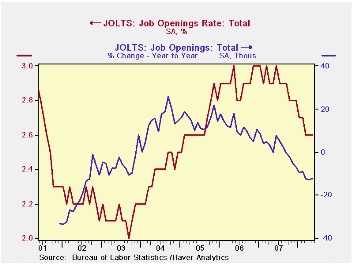 Global| Jul 09 2008
Global| Jul 09 2008JOLTS: May Job Openings Up Minimally - Hires Plunged
by:Tom Moeller
|in:Economy in Brief
Summary
The Bureau of Labor Statistics reported in the Job Openings & Labor Turnover Survey (JOLTS) that for May, the number of job openings rose 0.4% from April. The rise followed April's 1.6% drop after declines during most of the prior [...]

The Bureau of Labor Statistics reported in the Job Openings & Labor Turnover Survey (JOLTS) that for May, the number of job openings rose 0.4% from April. The rise followed April's 1.6% drop after declines during most of the prior twelve months. Since their peak in January of 2007, the number of job openings have fallen 14%.
In addition, the job openings rate during May was unchanged m/m at 2.6%. The latest figures are down from near 3% one year ago. The job openings rate is the number of job openings on the last business day of the month as a percent of total employment plus job openings.
The actual number of job openings in the manufacturing sector fell 3.3% (-31.0% y/y) in May and professional & business services job openings fell 11.1% (-11.2% y/y). Job openings in the education & health sectors also fell but by a more moderate 1.8% (-3.9% y/y) and job openings in retail trade surged 13.3% (7.9% y/y).
By region, openings in the South were weakest, off 19.2% y/y. In the Midwest openings fell a lesser 5.6% and they were off 8.0% y/y in the West. In the Northeast job openings also fell 8.0% y/y .
The hires rate plunged to 3.1% from 3.4% in April.The hires rate is the number of hires during the month divided by employment.The latest figure was the lowest since 2003. The actual number of hires plunged 8.8% (-11.8% y/y) and that was the sharpest m/m decline in the series' short record which extends back to 2001. Hires in the trade & transportation sectors fell 11.5% (-20.5% y/y) and construction sector hiring plunged 22.1% (-15.5% y/y).
The job separations rate held stable m/m at 3.2%, down from 3.7% at the peak. Separations include quits, layoffs, discharges, and other separations as well as retirements. The level of job separations fell 3.5% y/y.
The JOLTS survey dates only to December 2000 but has since followed the movement in nonfarm payrolls, though the actual correlation between the two series is low.
A description of the Jolts survey and the latest release from the U.S. Department of Labor is available here.
Bank Lending , Financing Constraints and SME Investment is a working paper from the Federal Reserve Bank of Chicago and it can be found here.
| JOLTS (Job Openings & Labor Turnover Survey) | May | April | May '07 | 2007 | 2006 | 2005 |
|---|---|---|---|---|---|---|
| Job Openings, Total | ||||||
| Rate (%) | 2.6 | 2.6 | 2.9 | 2.8 | 3.0 | 2.8 |
| Total (000s) | 3,626 | 3,612 | 4,133 | 3,974 | 4,272 | 3,863 |
| Hires, Total | ||||||
| Rate (%) | 3.1 | 3.4 | 3.5 | 41.9 | 43.4 | 43.1 |
| Total (000s) | 4,301 | 4,715 | 4,875 | 57,771 | 59,153 | 57,501 |
Tom Moeller
AuthorMore in Author Profile »Prior to joining Haver Analytics in 2000, Mr. Moeller worked as the Economist at Chancellor Capital Management from 1985 to 1999. There, he developed comprehensive economic forecasts and interpreted economic data for equity and fixed income portfolio managers. Also at Chancellor, Mr. Moeller worked as an equity analyst and was responsible for researching and rating companies in the economically sensitive automobile and housing industries for investment in Chancellor’s equity portfolio. Prior to joining Chancellor, Mr. Moeller was an Economist at Citibank from 1979 to 1984. He also analyzed pricing behavior in the metals industry for the Council on Wage and Price Stability in Washington, D.C. In 1999, Mr. Moeller received the award for most accurate forecast from the Forecasters' Club of New York. From 1990 to 1992 he was President of the New York Association for Business Economists. Mr. Moeller earned an M.B.A. in Finance from Fordham University, where he graduated in 1987. He holds a Bachelor of Arts in Economics from George Washington University.






